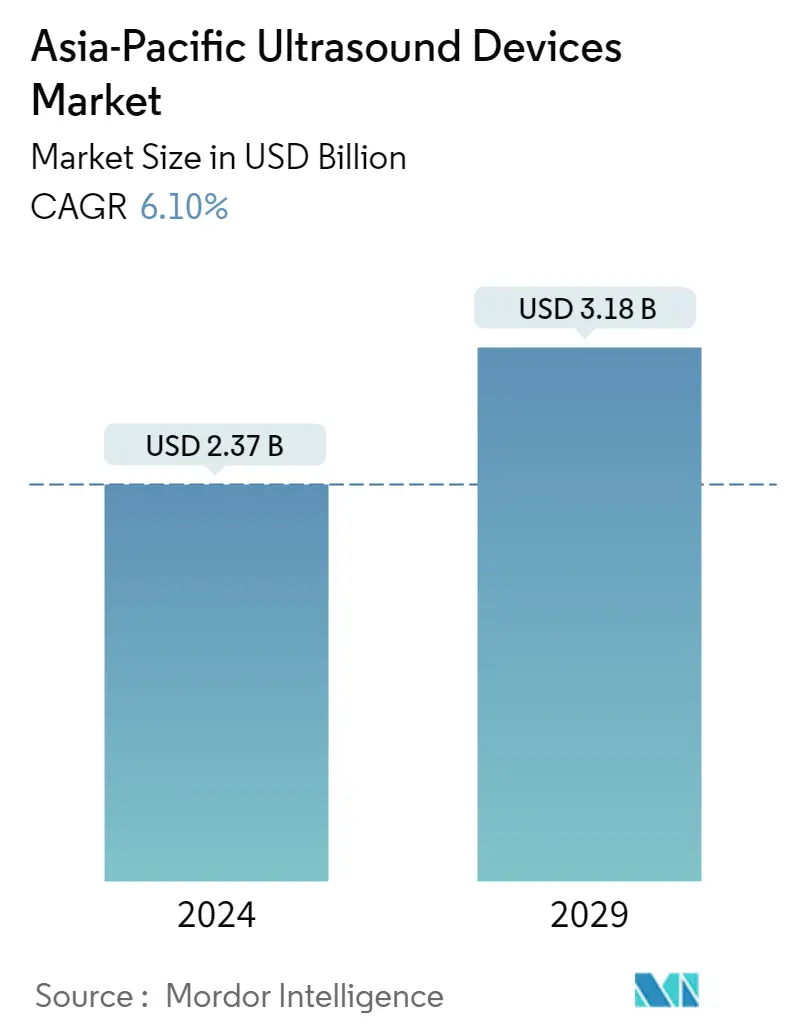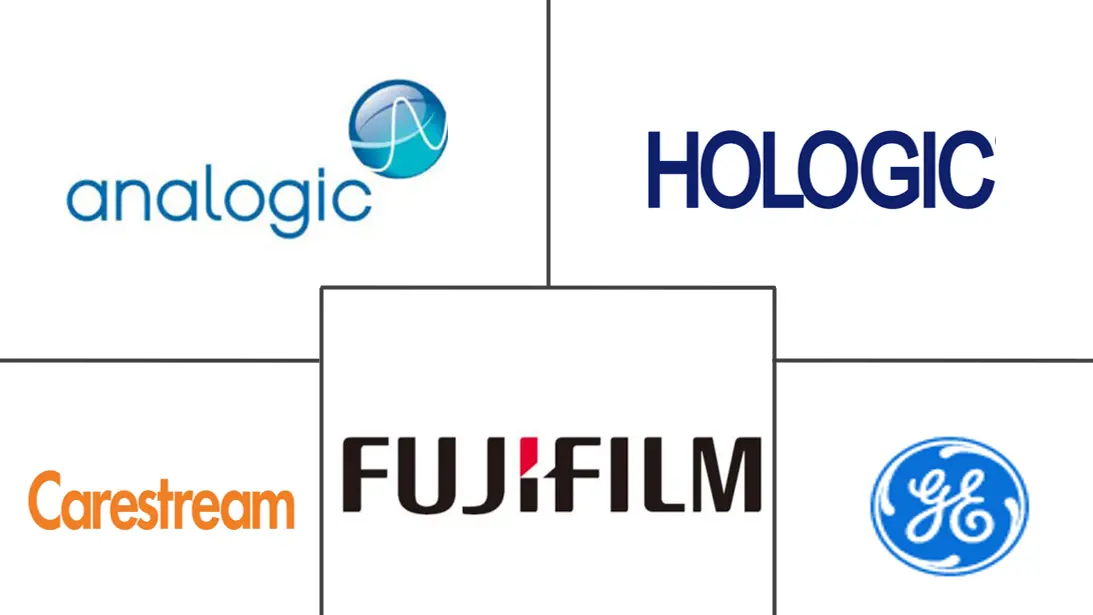Market Size of Asia-Pacific Ultrasound Devices Industry

| Study Period | 2019 - 2029 |
| Base Year For Estimation | 2023 |
| Forecast Data Period | 2024 - 2029 |
| Market Size (2024) | USD 2.37 Billion |
| Market Size (2029) | USD 3.18 Billion |
| CAGR (2024 - 2029) | 6.10 % |
Major Players
*Disclaimer: Major Players sorted in no particular order |
Asia-Pacific Ultrasound Devices Market Analysis
The Asia-Pacific Ultrasound Devices Market size is estimated at USD 2.37 billion in 2024, and is expected to reach USD 3.18 billion by 2029, growing at a CAGR of 6.10% during the forecast period (2024-2029).
The COVID-19 pandemic has impacted the growth of various sectors including healthcare, biotechnology, pharmaceutical industries, and various markets, including the ultrasound market in the Asia-Pacific region. The ultrasound market has been severely impacted by the pandemic due to the lockdown imposition and high infectivity of the SARS-CoV-2 virus. For instance, an article titled, 'Diagnostic Ultrasound Services During the Coronavirus Disease (COVID-19) Pandemic' published in November 2020 reported that diagnostics were at high risk of contamination and infection transmission as it requires extensive logistical planning for intrahospital patient transport, healthcare provider safety, and post-imaging decontamination. Thus, due to all these reasons, the demand for ultrasound devices got reduced due to the halt in emergency procedures. The unfavorable changes in regulations and guidelines hampered the growth of this market. The closing down of manufacturing facilities due to lockdowns, disruptions in supply chains, and recruitment challenges for clinical trials have further impacted the growth of the overall Asia-Pacific ultrasound market. However, after a few months due to the ease in the government restrictions, the hospital services got to resume the market witnessed significant growth.
The factors that are expected to be driving the Asia-Pacific ultrasound devices market are growing public awareness about the need for diagnosis, increased adoption of diagnostic imaging, an increasingly aging population, and rapid technological advancements. The increasing awareness of getting the disease diagnosed by ultrasound devices is propelling the growth of the studied market in the region. For instance, an article titled, 'Implementation of a large-scale breast cancer early detection program in a resource-constrained setting: real-world experiences from 2 large states in India' published in May 2022 reported that an estimated 178,361 new breast cancer cases were reported in India in 2020. The article reported that many initiatives are launched by the government to increase early breast cancer detection and individuals in the region are getting aware of early detection of breast cancers, which is fueling the growth of the studied market. The increased adoption of diagnostic imaging is another reason for driving this market as minimally invasive therapies and image-guided procedures are increasingly being adopted by healthcare professionals and patients across the Asia-Pacific region. The higher incidence of chronic diseases-such as cancer, stroke, and neurological and cardiovascular diseases-and the higher death rates in these countries, and the increasing awareness among the population for early diagnosis detection. For instance, an article titled, 'Early detection of melanoma in specialized primary care practice in Australia' published in February 2021 reported the public awareness of fast-growing melanoma and the primary care skin cancer clinics to facilitate early treatment of melanoma in Australia. Thus, the increasing prevalence of chronic diseases and the application of ultrasound in the diagnosis and treatment of these diseases is expected to increase the adoption of ultrasound and thus, fueling growth in the studied market.
An increasingly aging population in the region is constantly propelling the need for imaging diagnostics like ultrasound, and the risk of developing diseases increases proportionately with age. For instance, an article titled, 'Prevalence and potential determinants of chronic disease among elderly in India: Rural-urban perspectives' published in March 2022 reported that about 21% o the elderly in India reportedly have at least one chronic disease, 17% of elderly in rural areas and 29% in urban areas suffer from a chronic disease. The article also quoted that the elderly population in India is expected to grow to 158.7 million by 2025, which would be 11.1% of the total population. This increase in the aging population and the high incidence of chronic diseases associated with aging is driving the demand for improved healthcare facilities and advanced treatment options, thereby an increasing need for better diagnostics devices, to get the disease detected at an early stage, thereby propelling the growth of the Asia-Pacific ultrasound devices market. Moreover, the rapid technological advancements in ultrasound diagnosis such as orthopedic medical imaging provide a non-invasive approach to examining the internal structures of a patient to diagnose medical conditions. Also, it is used to offer high-quality imaging to reduce the requirement of surgeries and for decision-making. This medical imaging tool has proved to be an informational tool that has helped physicians to detect the disease and respond to the treatment. Thus, such technological advancements are constantly fueling the market. Thus, due to the aforesaid mentioned reasons, the market is expected to witness significant growth over the forecast period. However, reimbursement concerns and high costs associated with the devices and procedures may hinder the growth of the studied market.
Asia-Pacific Ultrasound Devices Industry Segmentation
As per the scope of the report, ultrasound, also known as sonography, is an imaging technique that uses high-frequency sound waves to produce images of the different structures inside the body. Ultrasound is being utilized for the assessment of various conditions of the kidney, liver, and other abdominal conditions. It is also majorly used for chronic diseases, which include health conditions, such as heart diseases, asthma, cancer, and diabetes. Thus, ultrasound devices are being utilized as both diagnostic imaging and therapeutic modality, and have a wide range of applications in the medical field. The Asia-Pacific ultrasound devices market is segmented by application (anesthesiology, cardiology, gynecology/obstetrics, musculoskeletal, musculoskeletal, critical care and other applications), technology (2D ultrasound imaging, 3D and 4D ultrasound imaging, doppler imaging, high-intensity focused ultrasound), type (stationary ultrasound, portable ultrasound), geography (China, Japan, India, Australia, South Korea, and Rest of Asia-Pacific). The report offers the value (in USD million) for the above segments.
| By Application | |
| Anesthesiology | |
| Cardiology | |
| Gynecology/Obstetrics | |
| Musculoskeletal | |
| Musculoskeletal | |
| Critical Care | |
| Other Applications |
| By Technology | |
| 2D Ultrasound Imaging | |
| 3D and 4D Ultrasound Imaging | |
| Doppler Imaging | |
| High-intensity Focused Ultrasound |
| By Type | |
| Stationary Ultrasound | |
| Portable Ultrasound |
| Geography | |
| China | |
| Japan | |
| India | |
| Australia | |
| South Korea | |
| Rest of Asia-Pacific |
Asia-Pacific Ultrasound Devices Market Size Summary
The Asia-Pacific ultrasound devices market is poised for significant growth over the forecast period, driven by increasing public awareness of diagnostic needs, the adoption of advanced imaging technologies, and a rapidly aging population. The market experienced initial setbacks due to the COVID-19 pandemic, which disrupted supply chains, halted manufacturing, and reduced demand due to postponed medical procedures. However, as restrictions eased, the market rebounded, fueled by the growing need for early disease detection and the rising incidence of chronic conditions such as cancer and cardiovascular diseases. Technological advancements in ultrasound imaging, including 3D and 4D technologies, are further propelling market growth by offering high-definition imaging and real-time visualization, which are crucial for minimally invasive procedures and accurate diagnostics.
China is expected to be a key growth driver within the region, supported by technological advancements, a burgeoning elderly population, and an increasing number of cancer cases. The country's focus on innovative applications of ultrasound imaging, such as lung ultrasound for neonatal diseases and COVID-19 pneumonia evaluation, underscores the technology's expanding role in healthcare. The competitive landscape of the Asia-Pacific ultrasound devices market is characterized by the presence of both global and regional players, including GE Healthcare, Philips Healthcare, and Fujifilm, among others. These companies are actively engaging in product launches and local manufacturing initiatives to strengthen their market positions and cater to the region's diverse healthcare needs.
Asia-Pacific Ultrasound Devices Market Size - Table of Contents
-
1. MARKET DYNAMICS
-
1.1 Market Overview
-
1.2 Market Drivers
-
1.2.1 Growing Public Awareness about Need for Diagnosis
-
1.2.2 Increasing Adoption of Diagnostic Imaging
-
1.2.3 Increasing Aging Population
-
1.2.4 Rapid Technological Advancements
-
-
1.3 Market Restraints
-
1.3.1 Reimbursement Concerns
-
1.3.2 High Costs Associated with the Devices and Procedures
-
-
1.4 Porter's Five Force Analysis
-
1.4.1 Threat of New Entrants
-
1.4.2 Bargaining Power of Buyers/Consumers
-
1.4.3 Bargaining Power of Suppliers
-
1.4.4 Threat of Substitute Products
-
1.4.5 Intensity of Competitive Rivalry
-
-
-
2. MARKET SEGMENTATION (Market Size by Value - USD million)
-
2.1 By Application
-
2.1.1 Anesthesiology
-
2.1.2 Cardiology
-
2.1.3 Gynecology/Obstetrics
-
2.1.4 Musculoskeletal
-
2.1.5 Musculoskeletal
-
2.1.6 Critical Care
-
2.1.7 Other Applications
-
-
2.2 By Technology
-
2.2.1 2D Ultrasound Imaging
-
2.2.2 3D and 4D Ultrasound Imaging
-
2.2.3 Doppler Imaging
-
2.2.4 High-intensity Focused Ultrasound
-
-
2.3 By Type
-
2.3.1 Stationary Ultrasound
-
2.3.2 Portable Ultrasound
-
-
2.4 Geography
-
2.4.1 China
-
2.4.2 Japan
-
2.4.3 India
-
2.4.4 Australia
-
2.4.5 South Korea
-
2.4.6 Rest of Asia-Pacific
-
-
Asia-Pacific Ultrasound Devices Market Size FAQs
How big is the Asia-Pacific Ultrasound Devices Market?
The Asia-Pacific Ultrasound Devices Market size is expected to reach USD 2.37 billion in 2024 and grow at a CAGR of 6.10% to reach USD 3.18 billion by 2029.
What is the current Asia-Pacific Ultrasound Devices Market size?
In 2024, the Asia-Pacific Ultrasound Devices Market size is expected to reach USD 2.37 billion.

